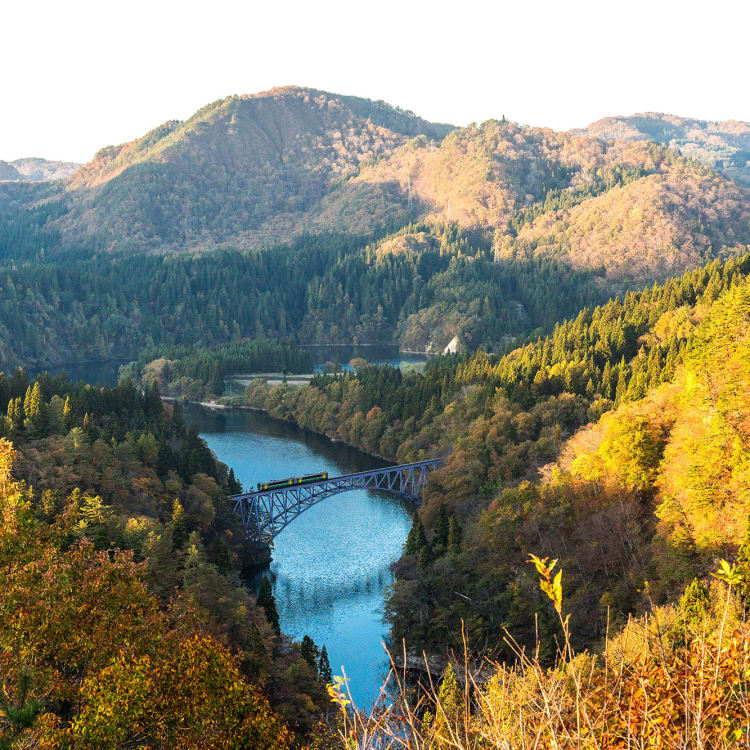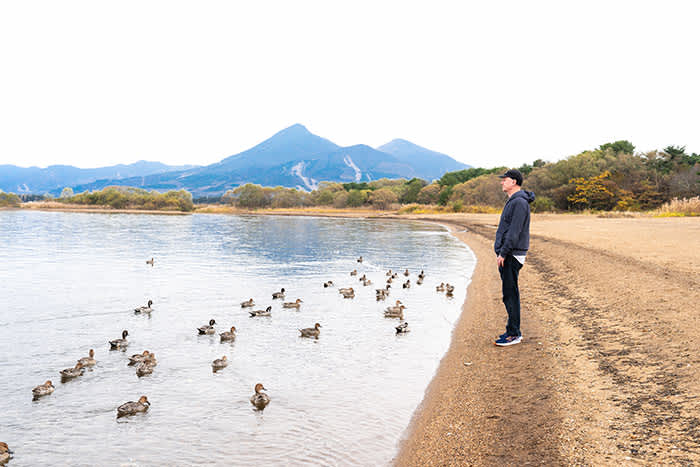
Travel Logs Aizu in Autumn A Land of Vivid Colors, Enduring Traditions, and a Rich Samurai History
Aizu in Fukushima is a land steeped in tradition and has a proud samurai spirit. Visitors will always feel welcome amongst its beautiful nature and historic streets. However autumn is a particularly great time to visit, with the golden foliage providing the perfect setting for a journey into Aizu’s profound history and culture.
Day 1
Our journey begins at Lake Inawashiro. The lake is Japan’s fourth largest freshwater lake. Known as “Heavenly Mirror Lake,” it offers up some stunning views, with Mt. Bandai also majestically in the background. It was the perfect place to begin exploring Aizu’s beautiful nature.

Our journey begins at Lake Inawashiro (This view can only be seen in winter).
Goshikinuma is a set of ‘five-colored ponds’ formed when Mt. Bandai erupted in 1888. We decided to walk the relatively flat pond trail, which is about 4 km and takes around 70-90 minutes.
As the sun hit, the five-colored reference made sense as the next pond burst into brilliant shades of green and blue.

Just look at those beautiful colors!
It was such a lovely site, with the distant mountains adding to the magic. This is how the rest of the walk panned out, with each following pond presenting new hues to appreciate. The trail ended with a superb view of Mt. Bandai over Bishamon, the largest pond. It was a wonderful, relaxing walk. The whole experience reminded me of a stroll through the English countryside!

Though we visited in autumn, Urabandai has lots to offer whatever the season. In winter, for example, visitors can see the Yellow Falls, a giant frozen waterfall formed from water leaking out from Mt. Bandai’s crater wall.

The frozen splendour of Urabandai’s Yellow Falls (This view can only be seen in winter).
That evening I stayed at Numajiri Kogen Lodge, which was founded by Junko Tabei, the first woman to climb Mt. Everest. The lodge reopened in 2019 after renovations and caters to guests who enjoy hiking or skiing in the nearby mountains in honour of Junko’s adventurous spirit.
The lodge has a magnificent hot spring that looks out toward Mt. Bandai. The lodge says its onsen has healing waters with the same acidity as a lemon. I can well believe it. It was so hot and relaxing, and my skin smelt so good afterwards, I could almost smell my body healing.

The onsen with its healing waters.
Dinner here is made from organic, local food. I ordered a vegan meal and it was wonderful. There were 8 dishes in total. I could write rhapsodies about each one. Suffice to say they were all delicious and beautifully presented.
Later, I retreated upstairs to a cosy lounge offering free whisky, wine and coffee. I had reached the Zen-like state that a great day, a hot bath and lovely food can bring you. After one more drink, it was time for my comfy bed.

The cosy lounge. The poster in the back is signed by Edmund Hillary, the first person to climb Everest.
Day 2
Extreme Onsen takes you on a 3-hour round trip to find the source of the area’s hot springs. The tour begins in Nowhere, the café next to Numajiri Kogen Lodge. From there, it’s a short drive to Numajiri trailhead parking lot. A sign here warns of poisonous volcanic gases. All the more reason why a guide is needed. Our guide led the way through the austerely beautiful volcanic landscape, where the only signs of civilization were pipes carrying spring water to local hotels.

Along the way, breathtaking views awaited, including the 150-meter-high Shiraito Falls.


Making my way through the austerely beautiful landscape.
Finally we arrived at our destination; a series of small waterfalls interspersed with pools of hot water. So, I stripped down, clambered up, and lowered myself in. This was the extreme onsen, and as I sat there in 40-degree waters amid a sulphuric alien landscape, it did feel a bit extreme, but in a really exhilarating way! Definitely an invigorating start to the day!

My mind now fully awake, it was time to learn about some history, so off we went to Aizu-Wakamatsu City to visit Tsurugajo Castle.

Tsurugajo Castle, the symbol of Aizu.
The castle has a long history dating back to 1384. However, it was badly damaged during the Boshin War and subsequently demolished in 1874. Only the original magnificent stone walls still remain. The castle itself was rebuilt in 1965, with the interior now used to display the castle’s history through exhibits, explanations, a diorama, and projection mapping shown on the castle walls. The view from the top is impressive too. So, all in all, a fantastic way to learn about the area and its samurai past.

The charming projection mapping show.
Apparently, my samurai spirit still needed polishing though, so it was back to school for me! Aizu Hanko Nisshinkan was founded in 1803 to educate and train the sons of samurai. The school continues to teach the ‘Ju no Okite’, a set of rules that reflects the educational philosophy of the former Aizu domain, to children in this region. One of the representative teachings within these rules is "Naranu koto wa naranu mono desu," which can be translated to "Do not do what you must not." Children are no longer banned from talking to women outside, but they are still expected to respect their seniors, something I can well get behind! The original school burnt down in the Boshin War. However, it was rebuilt in its new location in 1987. Visitors to the school can also take part in several activities including tea drinking and painting red cows.

This pond is said to be Japan’s oldest swimming pool. Pupils would also practice riding horseback in full armor.
I chose archery. The school has one of the longest outdoor ranges in Japan. All the better to show off my skills! I raised the bow, pulled back, and ping…swoooosh…thud…I didn’t hit the target. But I wasn’t far off! I was a ‘natural’, apparently. All those years playing darts had finally paid off. It was great fun and an experience I can heartily recommend.

I was told that the trick is to aim the arrow to the left of the target.
After all this excitement, it was time to get some rest. I was staying in Ookawaso, a hotel in Ashinomaki Onsen. It is said that the hotel inspired a location in the famous anime series, Demon Slayer: Kimetsu no Yaiba. It is indeed a magical, otherworldly place. The enchantment begins with a live shamisen performance in the lobby.

It really is like stepping back in time.
The hotel serves a kaiseki dinner made from locally sourced seasonal ingredients. If you ask ahead, you can get a vegan option too, which I did. The 7-course meal looked too good to eat. But eat it I did, and it was delicious! Then it was time for thehot spring. The hotel has two onsens, both looking out over the Okawa River valley. One is designed like a terraced rice field, with several baths cascading down. Sitting in the bottom bath with the mountain right before me, I thought, ‘Aaa, this is the life!” and with a full belly and soothed bones, I went back to my huge tatami room for some sleep.
Day 3
The third day began at Oyakuen Garden, a site of healing and relaxation. The feudal lord Hoshina Masatsune began cultivating medicinal herbs here around 1670.A pond and Japanese garden were added in the late 18th century. This visit was a highlight for me thanks in large part to our enthusiastic guide, who joined us on a stroll around the garden.

Our guide pointing out some features of the magnificent pond.
One drawcard is the 6-sided Rakujutei pavilion, which still bears sword marks from fighting during the Boshin War. The whole garden is a delight, from its ancient oaks and maples, to its mossy rocks and 300-year-old tea house. You can also feed the ducks! What more reasons do you need to visit!

The picturesque Rakujutei pavilion with its battle-scarred balcony.
The next stop was Sazaedo Temple on Mt. Iimori. There are buses travelling every 30 minutes in both directions around Aizu-Wakamatu’s attractions. Visitors can also purchase an Aizu Gurutto Card, a 2-day pass offers unlimited rides on Aizu’s trains and buses.

Sazaedo Temple
Sazaedo has a remarkable double-helix structure, with two staircases winding around a core structure filled with 33 different statues of the deity Kannon. In this way, visitors can make a mini pilgrimage past all the statues without bumping into anyone coming the other way.

One of Sazaedo’s two staircases. The other one is visible through the gap – it is hard to believe it’s a different staircase.
It is amazing, like a fairground attraction combined with an optical illusion. I had never seen anything like it – it’s another must-see!
Next, we headed to Kitakata, home to Shingu Kumano Shrine. Visitors to the shrine are greeted by a huge shimenawa rope at the entrance. The rope is made by local villagers and is replaced every four years.

The magnificent shimenawa rope at the entrance to Shingu Kumano Shrine.
The shrine itself is famous for its worship hall and a venerable old ginkgo tree. Known as ‘Nagatoko’, or ‘long floor,’ the hall has an impressive thatched roof and, even more strikingly, a total lack of walls, with the structure supported by 44 hefty pillars. Though exposed to the elements, the hall is afforded some protection from the nearby 800-year-old ginkgo tree.

Two old friends: Nagatoko Hall and the 800-year-old ginkgo tree.
The tree is a magnificent sight in autumn when its leaves blaze a brilliant yellow. The leaves were turning golden when we visited, and yes, it is rather lovely. The ginkgo tree is also illuminated during November nights.

I asked the tree how to grow old gracefully but it was keeping its secrets to itself.
Kitakata is one of the top three places for ramen in Japan. There are around 70 Kitakata ramen restaurants in total. During our visit to one of these local ramen restaurants, the head chef shared with us why the region’s ramen is so popular. The short answer: It’s all in the noodles. Kitakata’s noodles contain a lot of water – 40% compared to an average of 20%. This gives them a chewy texture while making them light on the stomach. The water itself comes from the melted snows of nearby Mt. Iide, with its softness bringing out the flavour of the dashi stock.

A bowl of Kitakata ramen enjoyed at one of the area's long-established restaurants.
And the ramen is certainly a hit with the locals, with the restaurant packed by 11:30 am when we visited. There is even a custom called “morning ramen,” with some local restaurants opening early from as early as 7:00 am for nearby residents and others who just can’t wait for their ramen fix.
Kitakata is a great place to stroll through. The area is also famous for storehouses. Traditionally used for storing miso, soy sauce and sake. The storehouses were once a sign of status, with the streets lined with a variety of grand, picturesque buildings.

A sake connoisseur’s paradise, with free samples just around the corner!
We popped into Yamatogawa Sake Brewery, which brews alcohol using water from Mt. Iide. You can taste the water from a fountain outside but the stronger stuff is found inside within dark earthen-floored cellars lined with sake bottles. They offered free samples so I tried three different drinks for research purposes of course! It was a thumbs-up from me!
Day 4
The final day began with a trip to Mishima-juku Roadside Station, a place for weary motorists to catch a break, grab some food, and buy regional produce. I purchased some Aizu whisky here.
However, the main purpose of our visit was to see some spectacular scenery. The station is also a short trek away from the Tadami River Viewpoint. The climb up is a little steep, but when you get there…words can’t really describe just how stunning it is, but just… wow. Take a look for yourself!

As you can imagine, the viewpoint is also popular with trainspotters. Apparently, the best time is around dawn when the sun is rising. Tadami Line trains only run once every few hours, so it might be an idea to check the times beforehand. Or, just take a picnic and sit up there for a while. It’s worth it!

It’s impossible not take a picture here.
Next, we headed to Mugenkyo, a ravine bisected by the Tadami River. It gets its name from the atmospheric mist that sometimes descends on summer days. The residents of Mifuke village used to sail across the river to go to work or school. However, in 1964 the village was destroyed in a landslide. There were no fatalities but the villagers had to relocate nearby, abandon Mifuke village,and cease the river crossings. However, the villagers wanted to keep the tradition alive, so the crossings started again in 2010, though this time for tourists. Now, boats need to be booked 5 days in advance. Options are also available to book breakfast on the boats or have a guided tour around the abandoned village.

A Jizo statue watches over the abandoned village.
We did the 45-minute round trip. As we made our way across the quiet waters, our oarsman recounted the area’s history and nature. Words won’t do justice to the ravine’s sheer beauty, but hopefully these pictures will.

It is such a pleasant, full-sensory experience, from the mountains reflected in the river, to the hypnotic swoosh of the oars and the cool feel of the water. I could have happily floated there for hours.
The only thing left to do was buy some souvenirs. Which reminds me – the red cows! The story begins with akabeko, a legendary red cow that helped build Enzoji Temple some 1,200 years ago. After hearing about akabeko many centuries later, Aizu’s then-lord Gamo Ujisato ordered his artisans to create a papier-mâché akabeko toy. And the rest is history. The akabeko is now a symbol of Aizu, with red cows everywhere you look. I bought a small akabeko keyring and a larger toy for my friend’s son. They are a lovely sight with their wobbly heads bobbing up and down.

A baby hitching a ride on a fully-grown akabeko.
And that really was it, save for the journey back to Tokyo. Aizu’s rich mix of nature, culture and history makes for an invigorating experience, and I left feeling physically and mentally refreshed.
As I sat on the shinkansen, I thought back over the trip. One thing that had impressed me was the harmonious relation between nature and tourism. From the seasonal local food, to the wonderful boat rides, and trips to mountainous hot springs, tourism in Aizu seems so attuned to nature and the seasons. This is something we can all learn from. I will certainly think more about my environmental impact, and the food I eat in future. And then there is the sheer beauty of Aizu itself. Wherever you go, and however you go, whether by car, bus, train or even boat, you will always encounter spectacular vistas filled with mountains, lakes, forests, expansive plains and picturesque towns. It is, without doubt, one of the most beautiful places that I’ve visited in Japan.
I had a fantastic time in Aizu, and I think you will too. There are so many magical adventures that await you there. So have a wonderful trip, and say hello to akabeko for me.



































































